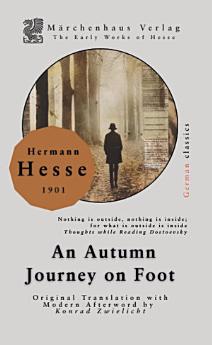An Autumn Journey on Foot
The Early Works of Hermann Hesse 第 27 本图书 · Marchen Press
电子书
92
页
family_home
符合条件
info
report评分和评价未经验证 了解详情
关于此电子书
In 1901, a twenty-four-year-old Herman Hesse embarked on a walking tour through the autumn landscapes of rural Germany, an experience that would give birth to his early work Eine Fussreise im Herbst (An Autumn Journey on Foot). This modest travel account emerges from a critical period in Hesse's life, as he struggled to establish himself as a writer while grappling with questions of personal identity and vocation. The text offers more than mere description of countryside scenery. Through Hesse's wanderings, we see the beginnings of themes that would mature throughout his career: the seeking soul, the tension between nature and civilization, the need for solitude, and the quest for self-knowledge. This short essay was also re-printed a few years later in his 1905 collection "This Side" (Diesseits). Hesse's journey occurs at a time when German culture was experiencing the aftermath of rapid industrialization. The rural landscapes he traverses stand in contrast to urban centers expanding across Germany. His intimate descriptions of forests, rivers, and small villages reveal not nostalgia but rather an attempt to locate genuine experience in a world growing increasingly mechanical and alienated. This slim travelogue, penned after Hesse’s wanderings through the Swiss Alps and northern Italy, blends topographic observation with meditations on impermanence. Published in Basel, the narrative eschews romanticized depictions of nature, instead fixating on decaying villages and the ephemerality of human endeavors. Though minor in scope, An Autumn Journey crystallizes Hesse’s emergent philosophy of rooted transience. Its unadorned descriptions of peasant life and weather-beaten landscapes reject idealized pastoralism, privileging instead a stoic acceptance of cyclical decay. The text’s subdued tone and anti-touristic ethos would later resonate in the works of mid-century existentialists, who similarly sought meaning in mundane perseverance. This new edition features a contemporary translation of Hermann Hesse's early work, making his philosophical and existential literature accessible to modern readers. Enhanced by an illuminating afterword that focuses on Hesse's personal and intellectual relationship with Carl Jung, a concise biography, a glossary of essential philosophical terms integral to his writings, and a detailed chronology of his life and major works, this robust edition introduces readers to the brilliance of Hesse's literature. It captures the depth and nuance of Hesse’s thought and highlights its enduring impact on contemporary culture and spiritual inquiry throughout the 20th century.
作者简介
Herman Hesse (1877-1962) navigated a life shaped by psychological turbulence that fundamentally transformed his literary vision following his pivotal encounter with Carl Jung's analytical psychology. After suffering a severe breakdown in 1916 amid his crumbling first marriage and the ravages of World War I, Hesse underwent intensive psychoanalysis with Jung's student J.B. Lang and later with Jung himself, sessions that would profoundly alter his creative trajectory. This Jungian influence became evident in his subsequent works, particularly "Demian" and "Steppenwolf," where the protagonist's journey toward individuation—Jung's concept of integrating the conscious and unconscious aspects of personality—emerges as a central theme. Hesse's correspondence with Jung continued for decades, their intellectual relationship deepening as Hesse increasingly incorporated Jungian archetypes, dream symbolism, and the notion of the shadow self into his narratives of spiritual seeking. The writer later acknowledged that Jung's therapeutic methods had not only rescued him from psychological collapse but had fundamentally reshaped his understanding of human consciousness, enabling him to transmute his personal suffering into the allegorical quests for wholeness that characterized his most enduring works.RetryClaude can make mistakes. Please double-check responses.
为此电子书评分
欢迎向我们提供反馈意见。
如何阅读
智能手机和平板电脑
笔记本电脑和台式机
您可以使用计算机的网络浏览器聆听您在 Google Play 购买的有声读物。
电子阅读器和其他设备
如果要在 Kobo 电子阅读器等电子墨水屏设备上阅读,您需要下载一个文件,并将其传输到相应设备上。若要将文件传输到受支持的电子阅读器上,请按帮助中心内的详细说明操作。











